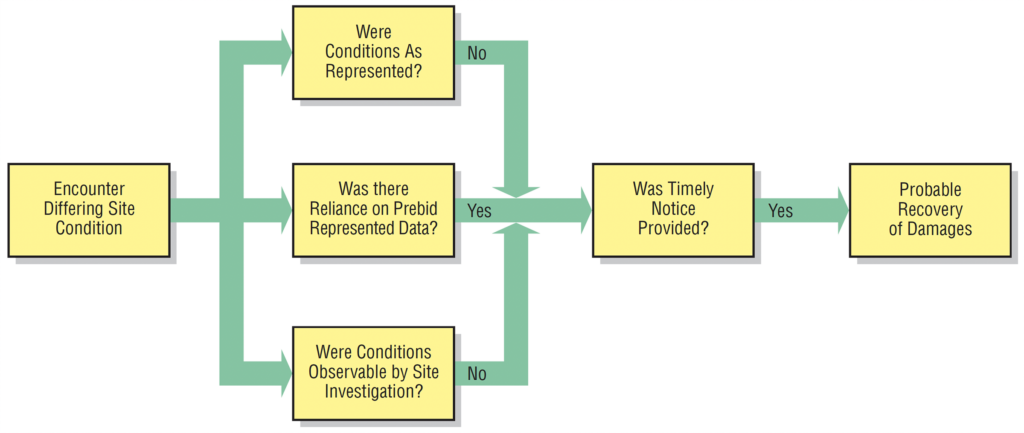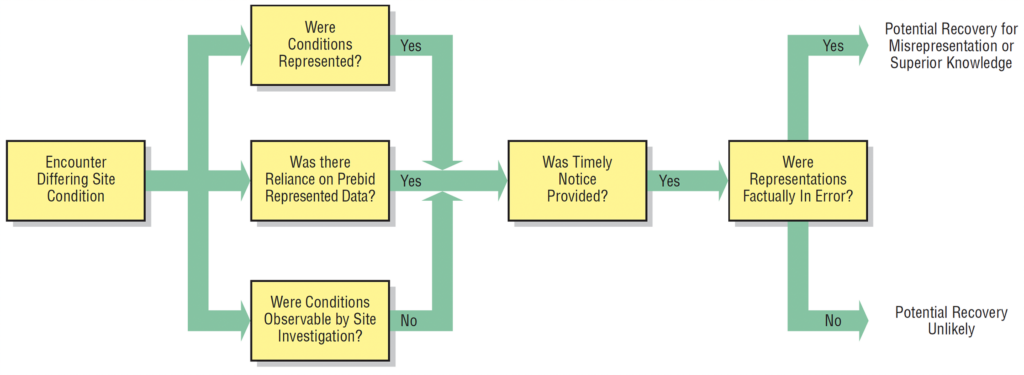
September 11, 2023
Differing Site Conditions: Contracts
This is the second of two blog posts about differing site conditions (DSC). The first post explained Types I, II, and III DSC and DSC claims. This post explores contract language and paths by which a contractor might recover from DSC.
In an effort to secure more realistic bids by eliminating contractor contingencies to cover unknown subsurface conditions, owners have become more willing to make positive representations as to expected subsurface conditions. However, owners have also tried to avoid liability for any deviations from those expected conditions—by including a “Site Investigation” clause in the contract, disclaiming the accuracy of subsurface data, requiring the contractor to sign a release before the owner will provide the subsurface data, and not including a DSC clause in the contract. As a result, a dichotomy is born within the contract. The owner provides data on subsurface conditions on which a contractor will likely rely, while at the same time, the owner includes contract language to avoid liability should the information prove incorrect.
For all DSC claims, the contract documents are critical. First, they can be the source of the claim if they describe a condition different from that found at the site. Second, they usually contain disclaimers about site information provided by the owner either in the bid package or in separate documents, such as the following:
It is hereby declared and agreed by the contractor that this agreement has been entered into by the contractor on the contractor’s own knowledge respecting the nature and conformation of the ground on which the work is to be done; the location, character, quality and quantities of the material to be removed; the character of the equipment and facilities needed; the general and local conditions and all other matters which can affect the work under this agreement, and the contractor does not rely upon any information given or statement made to the contractor in relation to the work by the owner.
Disclaimers are less of a problem, however, in federal construction contracts because of the rule that, where an agency’s regulations require inclusion of a particular contract provision, that provision is automatically included by operation of law notwithstanding its absence from a particular contract. The effect of this rule, as applied to DSC, is that the federal government may not prevent the contractor’s recovery under the DSC clause by including a disclaimer clause in the same contract.
The most effective defense against a DSC claim is that the contractor failed to provide proper notice to the owner. Contracts often contain a notice requirement, particularly regarding DSC. Contracts may also require that the DSC remain undisturbed until the owner can investigate. Failure to strictly adhere to these notice requirements may foreclose a contractor’s recovery for an otherwise valid DSC claim. The notice requirement is necessary to afford the owner the opportunity to inspect the condition and modify or alter the design or performance requirements to minimize or mitigate the effects of the DSC.
Because all DSC clauses attempt to allocate risk, the exact wording in the clause along with the specific DSC encountered will determine the contractor’s entitlement under a DSC claim. The contractor is well advised to thoroughly read and understand the allocation of risk language in the contract prior to submitting a bid or negotiating a contract. However, such clauses benefit both the owner and the contractor. Allocating the risk allows the contractor to submit a more precise and competitive bid without high contingency factors.
Absent a DSC clause in the contract, the contractor’s only avenue to recovery for encountering DSC is under the principles or theories of common law. Figures 1 and 2 present recovery paths with and without a DSC clause in the contract. Several common law theories may provide the contractor a basis for recovery from DSC. These include misrepresentation, fraud, breach of contract, breach of warranty, mutual mistake, superior knowledge, and unjust enrichment.
Figure 1
Liability/Notice Flowchart for DSC Contract Containing a DSC Clause

Figure 2
Liability/Notice Flowchart for DSC Contract Absent a DSC Clause

Encountering differing site conditions can be financially catastrophic to a contractor. An assessment of the contractual allocation of risks should be performed before a bid is submitted. Questions that a prudent contractor should ask during bid preparation include the following:
- Is there a DSC clause in the contract?
- Are the boring logs (and other geotechnical data) part of the contract?
- Are there exculpatory clauses wherein the owner denies responsibility for incorrect subsurface conditions?
For a more detailed discussion of DSC, please see the Long International article “Differing Site Conditions.”
ADDITIONAL RESOURCES

Blog
Discover industry insights on construction disputes and claims, project management, risk analysis, and more.
MORE

Articles
Articles by our engineering and construction claims experts cover topics ranging from acceleration to why claims occur.
MORE

Publications
We are committed to sharing industry knowledge through publication of our books and presentations.
MORE
RECOMMENDED READS
Differing Site Conditions: Types and Claims
This is the first of two blog posts about differing site conditions (DSC). It explains Types I, II, and III DSC and DSC claims.
READ
Differing Site Conditions
This article covers contractual representations, types of differing site conditions, the contract absent a differing site conditions clause, and owner defenses.
READ
Construction Claim Types for Contractors
U.S. federal and state courts recognize 19 basic construction claim entitlements for a contractor’s recovery of damages.
READ

